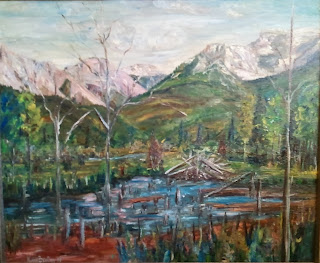The legendary "Treetops" hotel, Kenya. View of back with waterhole
We stopped first at Treetops hotel, the very spot where a young Princess named Elizabeth succeeded to the Crown and became Queen: on the night of February 5, 1952 back in England, her father King George VI died in his sleep. She immediately became Queen, even though she didn't learn of his death until the next day and immediately cut short her visit to Kenya to return home.
You have to walk quite a way from the spot where we parked. My host carried a rifle to keep the wildlife at bay. No sooner had we taken a few steps when the baboons showed up. One snatched my bottle of water right out of my hands and sped away. We were told they love to snatch anything. The Treetops is right beside a big waterhole where animals come to quench their thirst. As a result there are excellent opportunities for sightings of many creatures.
Princess Elizabeth at Treetops, before learning the news of her father's death while she was in Kenya, 'whereupon she immediately succeeded to the Throne' and became Queen Elizabeth II
You have to walk quite a way from the spot where we parked. My host carried a rifle to keep the wildlife at bay. No sooner had we taken a few steps when the baboons showed up. One snatched my bottle of water right out of my hands and sped away. We were told they love to snatch anything. The Treetops is right beside a big waterhole where animals come to quench their thirst. As a result there are excellent opportunities for sightings of many creatures.
Not a worry in the world. Sleep of the innocent.
All the
guest rooms are located at the back of the building, which overlooks the
waterhole. The tradition at Treetops is you are given a card where
you mark with an “x” the various creatures you observe from your window. Giraffes,
Zebras, Wildebeest, Bongos (rare and shy) and other types of antelope and
Gazelles, to name a few. At night Lions arrived. Suddenly I noticed a small
creature peering through my corner window, the only one with a tree. He was
sitting on a branch. It had huge eyes.
He may be nocturnal, but I also had to become nocturnal in order to spot him
Checking my list, I
noticed the word “Nocturnal Bush baby”, and made a guess, checking that box
with an “x”. Very early, pre-dawn, Elephants appeared at the waterhole. I didn’t sleep a wink that night. An extraordinary 24 hours of close-up
wildlife encounters. Bush baby it was!
So, guessed right.
Leopard in tree, guarding his lunch. "That's my lunch, no one can get near it."
Continuing on our travels in the Landrover, we came
to Lake Nakuru. Myriads of Flamingoes
covered the Lake as far as we could see.
My host told me, “Clap your hands.’
Flamingoes, Lake Nakuru. It's not recommended you do this, but in those days you could clap your hands, and woooosh! the sky turned pink
I did, and the whole lot of Flamingoes took flight, painting the cobalt
blue sky - pink! An unforgettable sight. We caught sight of
many more animals en route to the region where the Maasai lived, our next stop.
The Maasai are nomads and cow-herders, famous for their more than average height.
For protein nourishment, they drink the blood of their cattle, mixed with milk
in a gourd. (The name “Kenya” means “gourd”.)
The Maasai, natural wanderers and cow herders
At night the Maasai protect
themselves and their cattle from lions and hyenas by encircling their livestock
and families with tall branches of the Acacia or Thorn Tree whose long, sharp
spikes deter predators. Yet we could hear the lions and laughing of the hyenas,
their eyes glowing in the reflected firelight.
But the campfire and thorn trees kept us safe.
Altogether, an amazing 12 days, a completely unexpected trip, and of course memorable.
Altogether, an amazing 12 days, a completely unexpected trip, and of course memorable.
To be continued. Next:
Part Four.
Henri van Bentum











.jpg)









